Article Critique: Peplau's Theory in Emergency and Rural Nursing
VerifiedAdded on 2022/08/29
|9
|2313
|22
Report
AI Summary
This report provides a comprehensive critique of an article by Senn (2013) focusing on the application of Hildegard Peplau's theory of interpersonal relations in emergency and rural nursing settings. The critique evaluates various aspects of the article, including the title, abstract, introduction, literature review, conceptual underpinnings, research design, findings, and implications. The report highlights the strengths and weaknesses of the article, such as the clarity of the title, the completeness of the literature review, and the absence of explicit research questions. The analysis also examines the author's expertise, the use of a grounded theory approach, and the presentation of findings through themes. The critique emphasizes the implications of Peplau's theory for nursing practice, particularly in diverse clinical environments, and assesses the overall trustworthiness and contribution of the study to the field of nursing. The report concludes with a summary assessment of the article's organization, presentation, and contribution to nursing practice, emphasizing the importance of skillful patient interaction within the clinical environment.

Running head: ARTICLE CRITIQUE 1
Article Critique: Senn, J. F. (2013). Peplau’s Theory of Interpersonal Relations: Application in
Emergency and Rural Nursing. Nursing Science Quarterly, 26(1), 331-35.
Student’s Name
University
Article Critique: Senn, J. F. (2013). Peplau’s Theory of Interpersonal Relations: Application in
Emergency and Rural Nursing. Nursing Science Quarterly, 26(1), 331-35.
Student’s Name
University
Paraphrase This Document
Need a fresh take? Get an instant paraphrase of this document with our AI Paraphraser
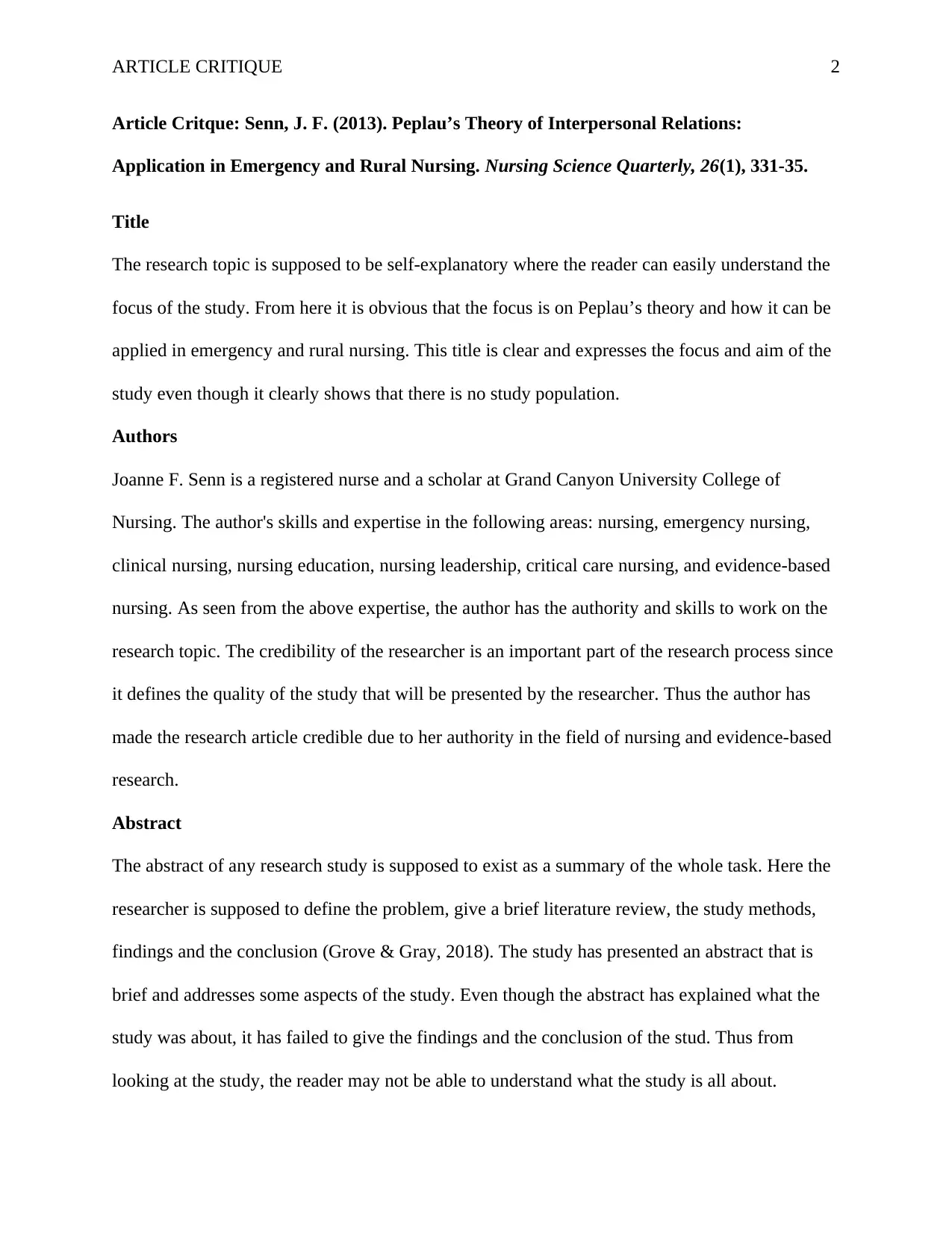
ARTICLE CRITIQUE 2
Article Critque: Senn, J. F. (2013). Peplau’s Theory of Interpersonal Relations:
Application in Emergency and Rural Nursing. Nursing Science Quarterly, 26(1), 331-35.
Title
The research topic is supposed to be self-explanatory where the reader can easily understand the
focus of the study. From here it is obvious that the focus is on Peplau’s theory and how it can be
applied in emergency and rural nursing. This title is clear and expresses the focus and aim of the
study even though it clearly shows that there is no study population.
Authors
Joanne F. Senn is a registered nurse and a scholar at Grand Canyon University College of
Nursing. The author's skills and expertise in the following areas: nursing, emergency nursing,
clinical nursing, nursing education, nursing leadership, critical care nursing, and evidence-based
nursing. As seen from the above expertise, the author has the authority and skills to work on the
research topic. The credibility of the researcher is an important part of the research process since
it defines the quality of the study that will be presented by the researcher. Thus the author has
made the research article credible due to her authority in the field of nursing and evidence-based
research.
Abstract
The abstract of any research study is supposed to exist as a summary of the whole task. Here the
researcher is supposed to define the problem, give a brief literature review, the study methods,
findings and the conclusion (Grove & Gray, 2018). The study has presented an abstract that is
brief and addresses some aspects of the study. Even though the abstract has explained what the
study was about, it has failed to give the findings and the conclusion of the stud. Thus from
looking at the study, the reader may not be able to understand what the study is all about.
Article Critque: Senn, J. F. (2013). Peplau’s Theory of Interpersonal Relations:
Application in Emergency and Rural Nursing. Nursing Science Quarterly, 26(1), 331-35.
Title
The research topic is supposed to be self-explanatory where the reader can easily understand the
focus of the study. From here it is obvious that the focus is on Peplau’s theory and how it can be
applied in emergency and rural nursing. This title is clear and expresses the focus and aim of the
study even though it clearly shows that there is no study population.
Authors
Joanne F. Senn is a registered nurse and a scholar at Grand Canyon University College of
Nursing. The author's skills and expertise in the following areas: nursing, emergency nursing,
clinical nursing, nursing education, nursing leadership, critical care nursing, and evidence-based
nursing. As seen from the above expertise, the author has the authority and skills to work on the
research topic. The credibility of the researcher is an important part of the research process since
it defines the quality of the study that will be presented by the researcher. Thus the author has
made the research article credible due to her authority in the field of nursing and evidence-based
research.
Abstract
The abstract of any research study is supposed to exist as a summary of the whole task. Here the
researcher is supposed to define the problem, give a brief literature review, the study methods,
findings and the conclusion (Grove & Gray, 2018). The study has presented an abstract that is
brief and addresses some aspects of the study. Even though the abstract has explained what the
study was about, it has failed to give the findings and the conclusion of the stud. Thus from
looking at the study, the reader may not be able to understand what the study is all about.
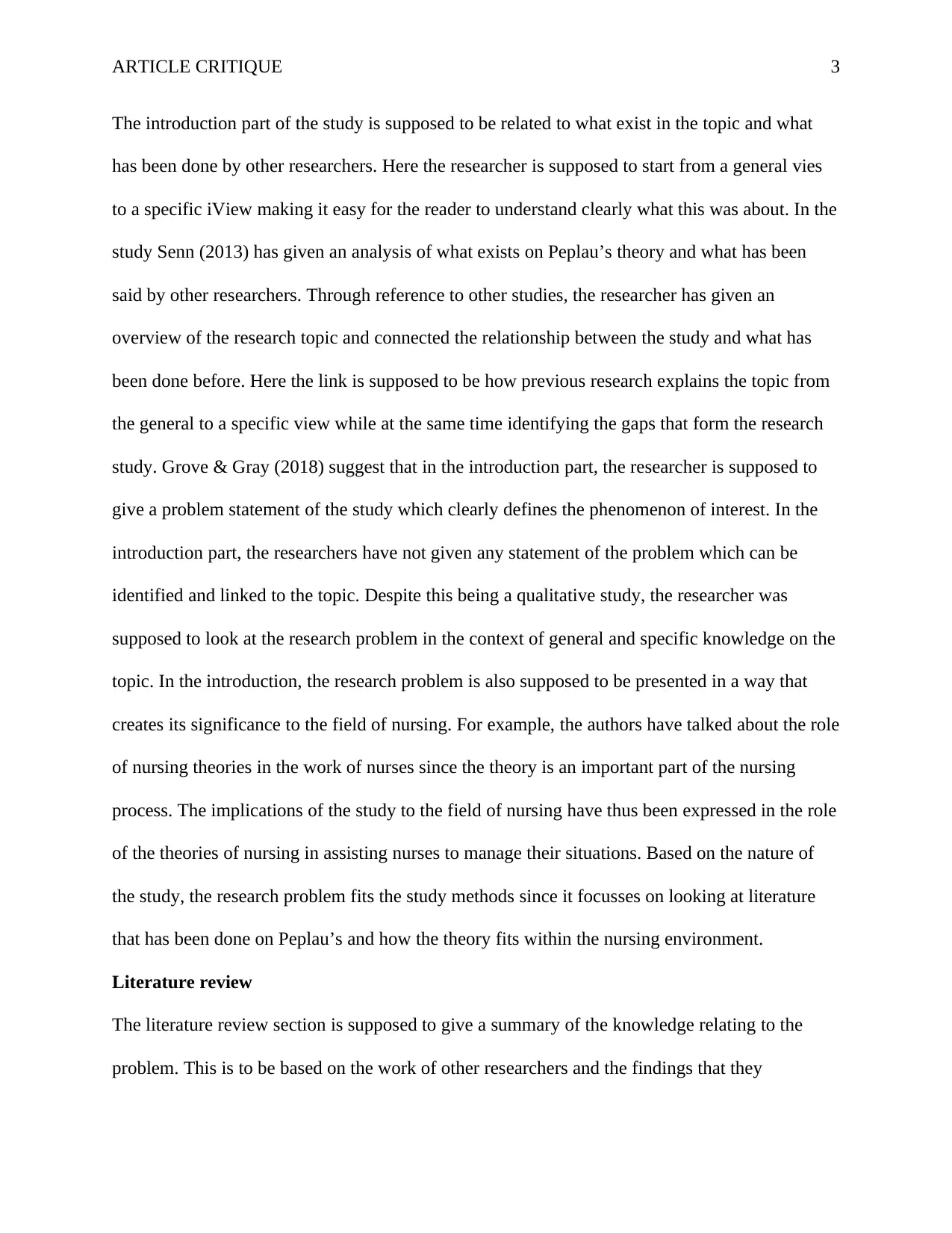
ARTICLE CRITIQUE 3
The introduction part of the study is supposed to be related to what exist in the topic and what
has been done by other researchers. Here the researcher is supposed to start from a general vies
to a specific iView making it easy for the reader to understand clearly what this was about. In the
study Senn (2013) has given an analysis of what exists on Peplau’s theory and what has been
said by other researchers. Through reference to other studies, the researcher has given an
overview of the research topic and connected the relationship between the study and what has
been done before. Here the link is supposed to be how previous research explains the topic from
the general to a specific view while at the same time identifying the gaps that form the research
study. Grove & Gray (2018) suggest that in the introduction part, the researcher is supposed to
give a problem statement of the study which clearly defines the phenomenon of interest. In the
introduction part, the researchers have not given any statement of the problem which can be
identified and linked to the topic. Despite this being a qualitative study, the researcher was
supposed to look at the research problem in the context of general and specific knowledge on the
topic. In the introduction, the research problem is also supposed to be presented in a way that
creates its significance to the field of nursing. For example, the authors have talked about the role
of nursing theories in the work of nurses since the theory is an important part of the nursing
process. The implications of the study to the field of nursing have thus been expressed in the role
of the theories of nursing in assisting nurses to manage their situations. Based on the nature of
the study, the research problem fits the study methods since it focusses on looking at literature
that has been done on Peplau’s and how the theory fits within the nursing environment.
Literature review
The literature review section is supposed to give a summary of the knowledge relating to the
problem. This is to be based on the work of other researchers and the findings that they
The introduction part of the study is supposed to be related to what exist in the topic and what
has been done by other researchers. Here the researcher is supposed to start from a general vies
to a specific iView making it easy for the reader to understand clearly what this was about. In the
study Senn (2013) has given an analysis of what exists on Peplau’s theory and what has been
said by other researchers. Through reference to other studies, the researcher has given an
overview of the research topic and connected the relationship between the study and what has
been done before. Here the link is supposed to be how previous research explains the topic from
the general to a specific view while at the same time identifying the gaps that form the research
study. Grove & Gray (2018) suggest that in the introduction part, the researcher is supposed to
give a problem statement of the study which clearly defines the phenomenon of interest. In the
introduction part, the researchers have not given any statement of the problem which can be
identified and linked to the topic. Despite this being a qualitative study, the researcher was
supposed to look at the research problem in the context of general and specific knowledge on the
topic. In the introduction, the research problem is also supposed to be presented in a way that
creates its significance to the field of nursing. For example, the authors have talked about the role
of nursing theories in the work of nurses since the theory is an important part of the nursing
process. The implications of the study to the field of nursing have thus been expressed in the role
of the theories of nursing in assisting nurses to manage their situations. Based on the nature of
the study, the research problem fits the study methods since it focusses on looking at literature
that has been done on Peplau’s and how the theory fits within the nursing environment.
Literature review
The literature review section is supposed to give a summary of the knowledge relating to the
problem. This is to be based on the work of other researchers and the findings that they
⊘ This is a preview!⊘
Do you want full access?
Subscribe today to unlock all pages.

Trusted by 1+ million students worldwide
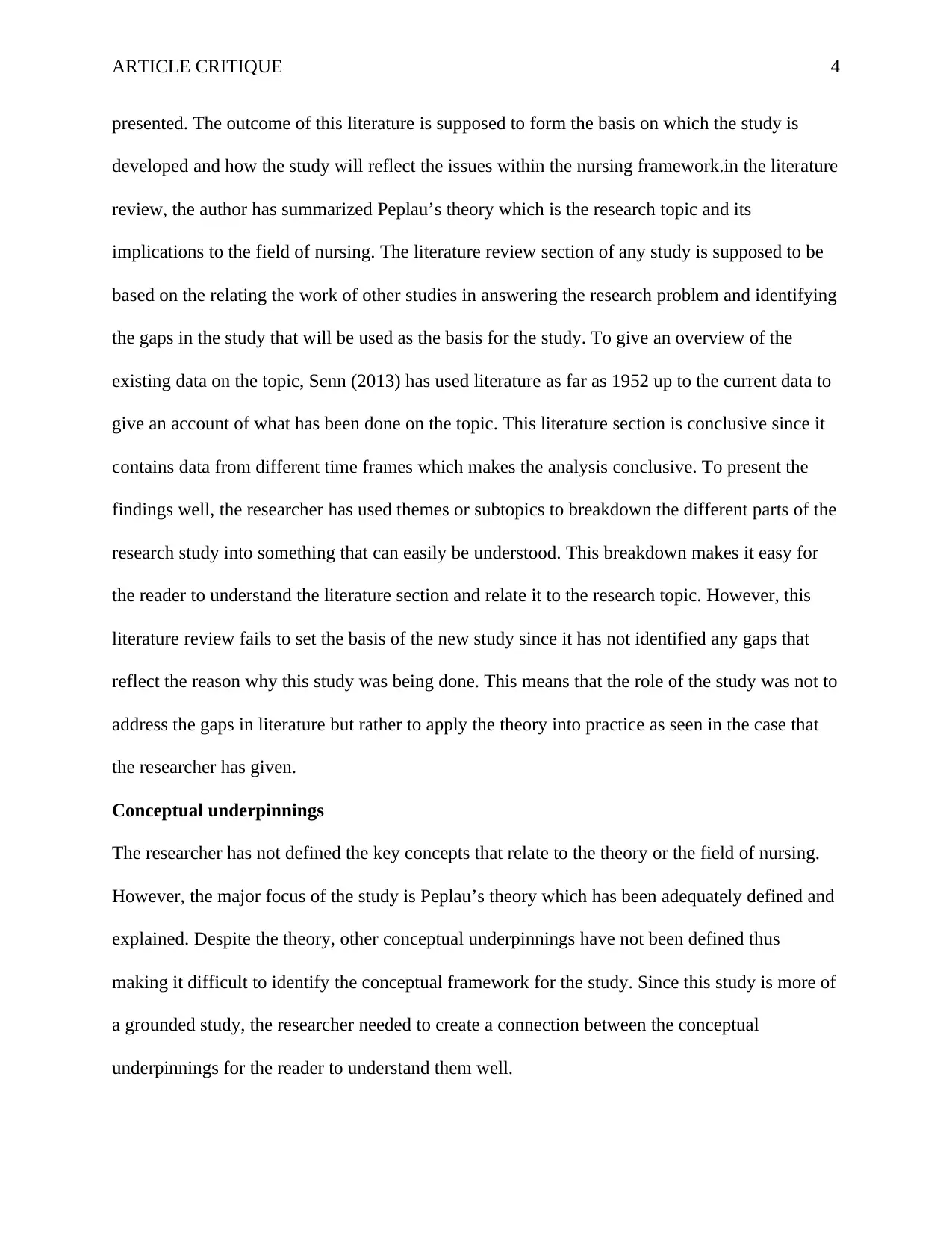
ARTICLE CRITIQUE 4
presented. The outcome of this literature is supposed to form the basis on which the study is
developed and how the study will reflect the issues within the nursing framework.in the literature
review, the author has summarized Peplau’s theory which is the research topic and its
implications to the field of nursing. The literature review section of any study is supposed to be
based on the relating the work of other studies in answering the research problem and identifying
the gaps in the study that will be used as the basis for the study. To give an overview of the
existing data on the topic, Senn (2013) has used literature as far as 1952 up to the current data to
give an account of what has been done on the topic. This literature section is conclusive since it
contains data from different time frames which makes the analysis conclusive. To present the
findings well, the researcher has used themes or subtopics to breakdown the different parts of the
research study into something that can easily be understood. This breakdown makes it easy for
the reader to understand the literature section and relate it to the research topic. However, this
literature review fails to set the basis of the new study since it has not identified any gaps that
reflect the reason why this study was being done. This means that the role of the study was not to
address the gaps in literature but rather to apply the theory into practice as seen in the case that
the researcher has given.
Conceptual underpinnings
The researcher has not defined the key concepts that relate to the theory or the field of nursing.
However, the major focus of the study is Peplau’s theory which has been adequately defined and
explained. Despite the theory, other conceptual underpinnings have not been defined thus
making it difficult to identify the conceptual framework for the study. Since this study is more of
a grounded study, the researcher needed to create a connection between the conceptual
underpinnings for the reader to understand them well.
presented. The outcome of this literature is supposed to form the basis on which the study is
developed and how the study will reflect the issues within the nursing framework.in the literature
review, the author has summarized Peplau’s theory which is the research topic and its
implications to the field of nursing. The literature review section of any study is supposed to be
based on the relating the work of other studies in answering the research problem and identifying
the gaps in the study that will be used as the basis for the study. To give an overview of the
existing data on the topic, Senn (2013) has used literature as far as 1952 up to the current data to
give an account of what has been done on the topic. This literature section is conclusive since it
contains data from different time frames which makes the analysis conclusive. To present the
findings well, the researcher has used themes or subtopics to breakdown the different parts of the
research study into something that can easily be understood. This breakdown makes it easy for
the reader to understand the literature section and relate it to the research topic. However, this
literature review fails to set the basis of the new study since it has not identified any gaps that
reflect the reason why this study was being done. This means that the role of the study was not to
address the gaps in literature but rather to apply the theory into practice as seen in the case that
the researcher has given.
Conceptual underpinnings
The researcher has not defined the key concepts that relate to the theory or the field of nursing.
However, the major focus of the study is Peplau’s theory which has been adequately defined and
explained. Despite the theory, other conceptual underpinnings have not been defined thus
making it difficult to identify the conceptual framework for the study. Since this study is more of
a grounded study, the researcher needed to create a connection between the conceptual
underpinnings for the reader to understand them well.
Paraphrase This Document
Need a fresh take? Get an instant paraphrase of this document with our AI Paraphraser
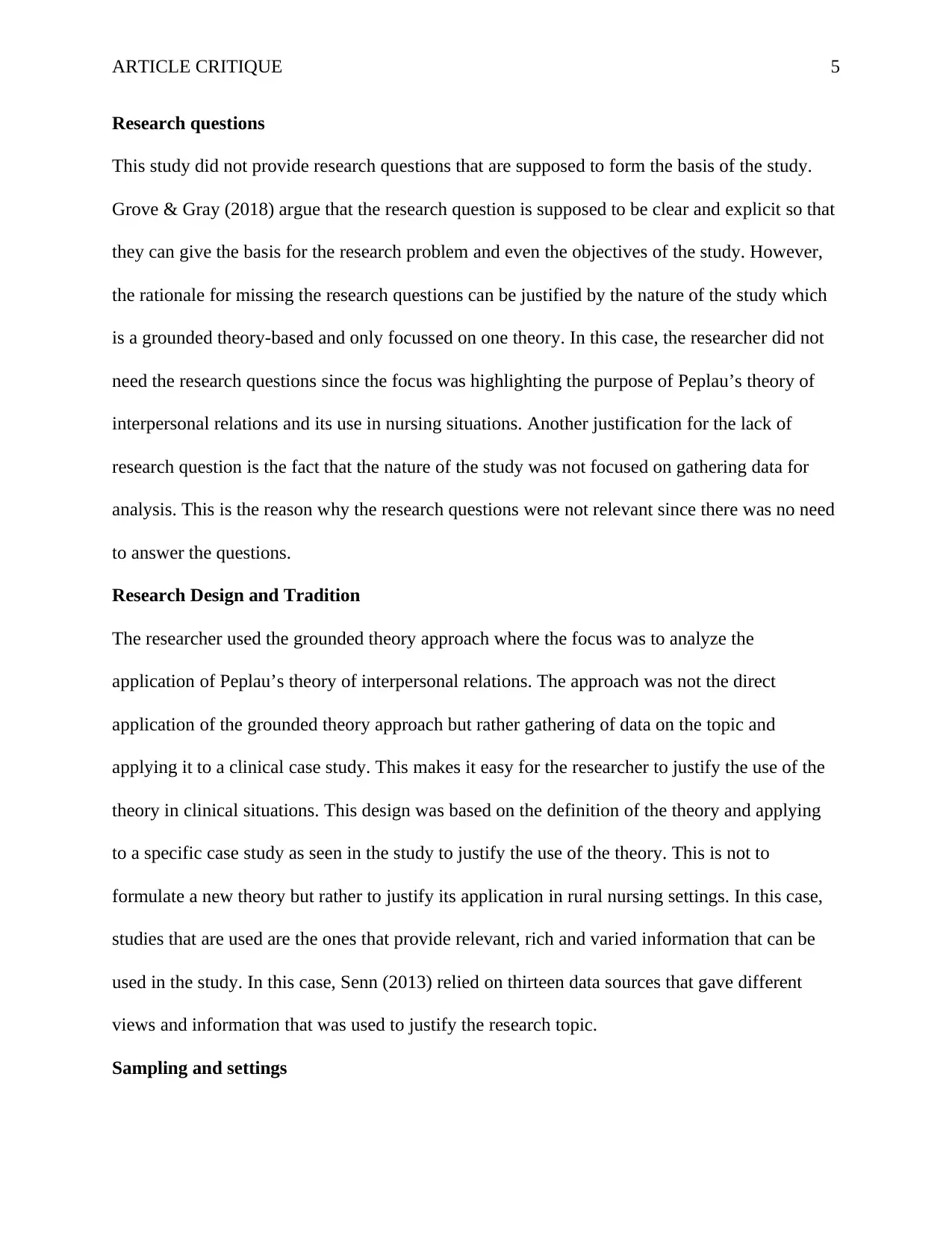
ARTICLE CRITIQUE 5
Research questions
This study did not provide research questions that are supposed to form the basis of the study.
Grove & Gray (2018) argue that the research question is supposed to be clear and explicit so that
they can give the basis for the research problem and even the objectives of the study. However,
the rationale for missing the research questions can be justified by the nature of the study which
is a grounded theory-based and only focussed on one theory. In this case, the researcher did not
need the research questions since the focus was highlighting the purpose of Peplau’s theory of
interpersonal relations and its use in nursing situations. Another justification for the lack of
research question is the fact that the nature of the study was not focused on gathering data for
analysis. This is the reason why the research questions were not relevant since there was no need
to answer the questions.
Research Design and Tradition
The researcher used the grounded theory approach where the focus was to analyze the
application of Peplau’s theory of interpersonal relations. The approach was not the direct
application of the grounded theory approach but rather gathering of data on the topic and
applying it to a clinical case study. This makes it easy for the researcher to justify the use of the
theory in clinical situations. This design was based on the definition of the theory and applying
to a specific case study as seen in the study to justify the use of the theory. This is not to
formulate a new theory but rather to justify its application in rural nursing settings. In this case,
studies that are used are the ones that provide relevant, rich and varied information that can be
used in the study. In this case, Senn (2013) relied on thirteen data sources that gave different
views and information that was used to justify the research topic.
Sampling and settings
Research questions
This study did not provide research questions that are supposed to form the basis of the study.
Grove & Gray (2018) argue that the research question is supposed to be clear and explicit so that
they can give the basis for the research problem and even the objectives of the study. However,
the rationale for missing the research questions can be justified by the nature of the study which
is a grounded theory-based and only focussed on one theory. In this case, the researcher did not
need the research questions since the focus was highlighting the purpose of Peplau’s theory of
interpersonal relations and its use in nursing situations. Another justification for the lack of
research question is the fact that the nature of the study was not focused on gathering data for
analysis. This is the reason why the research questions were not relevant since there was no need
to answer the questions.
Research Design and Tradition
The researcher used the grounded theory approach where the focus was to analyze the
application of Peplau’s theory of interpersonal relations. The approach was not the direct
application of the grounded theory approach but rather gathering of data on the topic and
applying it to a clinical case study. This makes it easy for the researcher to justify the use of the
theory in clinical situations. This design was based on the definition of the theory and applying
to a specific case study as seen in the study to justify the use of the theory. This is not to
formulate a new theory but rather to justify its application in rural nursing settings. In this case,
studies that are used are the ones that provide relevant, rich and varied information that can be
used in the study. In this case, Senn (2013) relied on thirteen data sources that gave different
views and information that was used to justify the research topic.
Sampling and settings
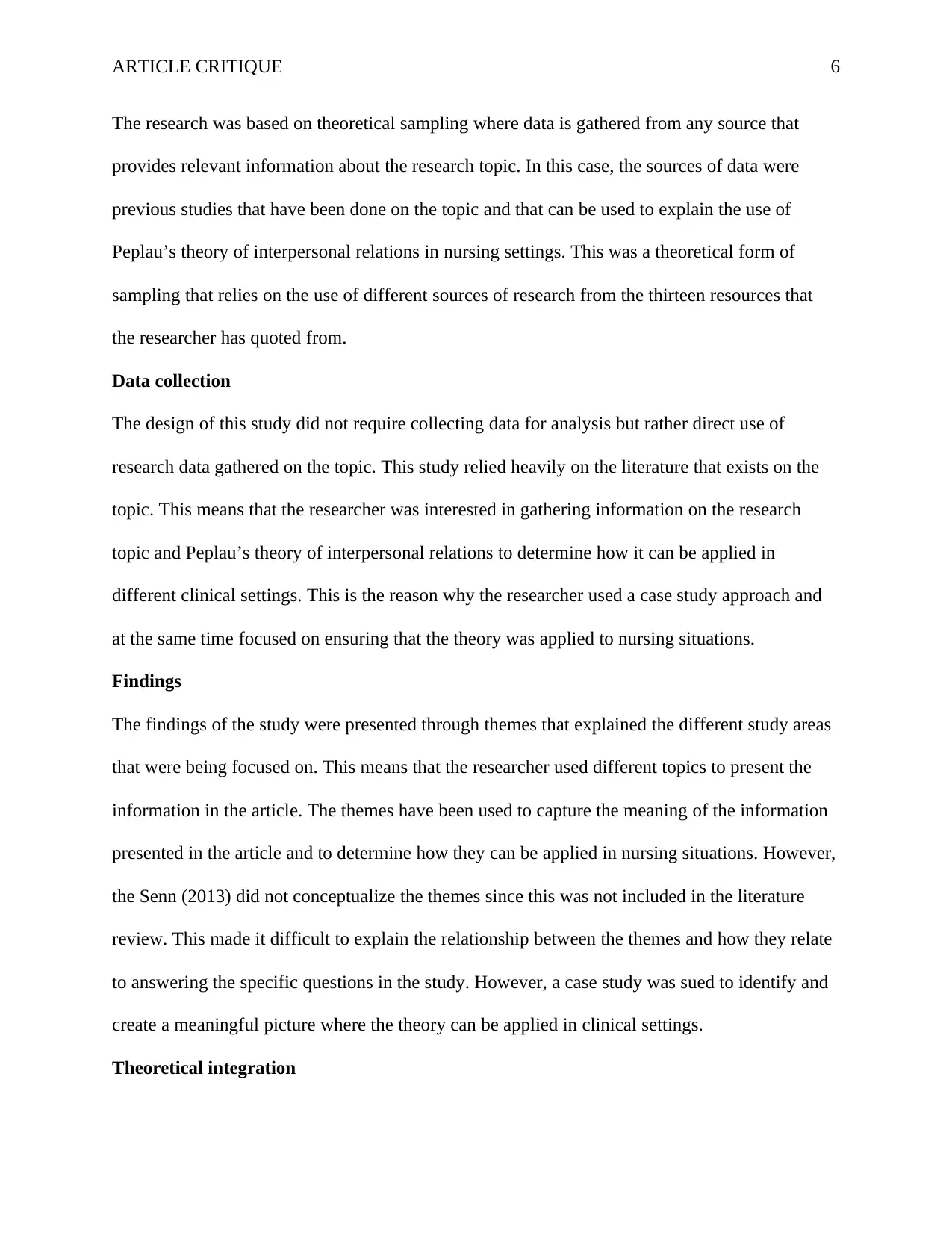
ARTICLE CRITIQUE 6
The research was based on theoretical sampling where data is gathered from any source that
provides relevant information about the research topic. In this case, the sources of data were
previous studies that have been done on the topic and that can be used to explain the use of
Peplau’s theory of interpersonal relations in nursing settings. This was a theoretical form of
sampling that relies on the use of different sources of research from the thirteen resources that
the researcher has quoted from.
Data collection
The design of this study did not require collecting data for analysis but rather direct use of
research data gathered on the topic. This study relied heavily on the literature that exists on the
topic. This means that the researcher was interested in gathering information on the research
topic and Peplau’s theory of interpersonal relations to determine how it can be applied in
different clinical settings. This is the reason why the researcher used a case study approach and
at the same time focused on ensuring that the theory was applied to nursing situations.
Findings
The findings of the study were presented through themes that explained the different study areas
that were being focused on. This means that the researcher used different topics to present the
information in the article. The themes have been used to capture the meaning of the information
presented in the article and to determine how they can be applied in nursing situations. However,
the Senn (2013) did not conceptualize the themes since this was not included in the literature
review. This made it difficult to explain the relationship between the themes and how they relate
to answering the specific questions in the study. However, a case study was sued to identify and
create a meaningful picture where the theory can be applied in clinical settings.
Theoretical integration
The research was based on theoretical sampling where data is gathered from any source that
provides relevant information about the research topic. In this case, the sources of data were
previous studies that have been done on the topic and that can be used to explain the use of
Peplau’s theory of interpersonal relations in nursing settings. This was a theoretical form of
sampling that relies on the use of different sources of research from the thirteen resources that
the researcher has quoted from.
Data collection
The design of this study did not require collecting data for analysis but rather direct use of
research data gathered on the topic. This study relied heavily on the literature that exists on the
topic. This means that the researcher was interested in gathering information on the research
topic and Peplau’s theory of interpersonal relations to determine how it can be applied in
different clinical settings. This is the reason why the researcher used a case study approach and
at the same time focused on ensuring that the theory was applied to nursing situations.
Findings
The findings of the study were presented through themes that explained the different study areas
that were being focused on. This means that the researcher used different topics to present the
information in the article. The themes have been used to capture the meaning of the information
presented in the article and to determine how they can be applied in nursing situations. However,
the Senn (2013) did not conceptualize the themes since this was not included in the literature
review. This made it difficult to explain the relationship between the themes and how they relate
to answering the specific questions in the study. However, a case study was sued to identify and
create a meaningful picture where the theory can be applied in clinical settings.
Theoretical integration
⊘ This is a preview!⊘
Do you want full access?
Subscribe today to unlock all pages.

Trusted by 1+ million students worldwide
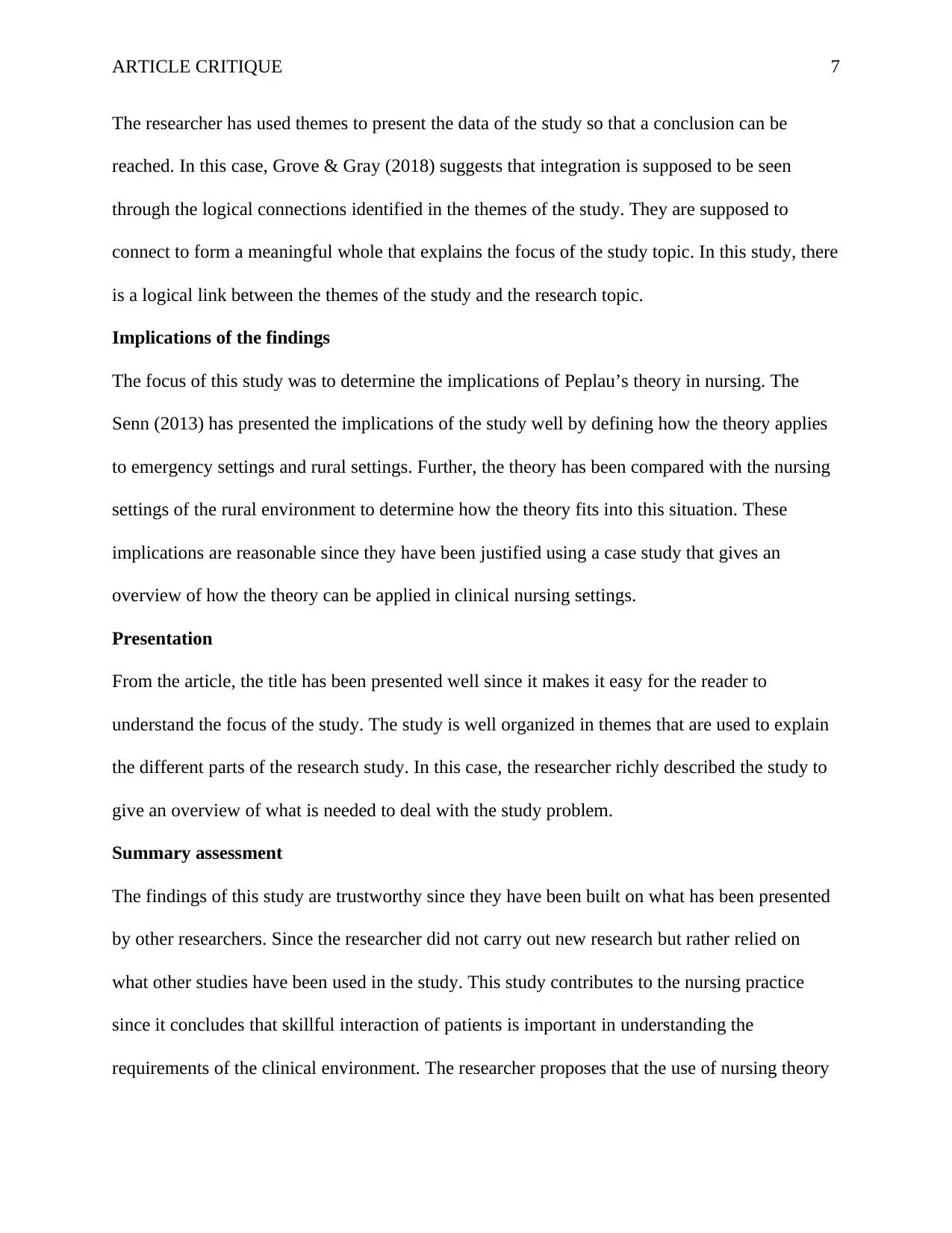
ARTICLE CRITIQUE 7
The researcher has used themes to present the data of the study so that a conclusion can be
reached. In this case, Grove & Gray (2018) suggests that integration is supposed to be seen
through the logical connections identified in the themes of the study. They are supposed to
connect to form a meaningful whole that explains the focus of the study topic. In this study, there
is a logical link between the themes of the study and the research topic.
Implications of the findings
The focus of this study was to determine the implications of Peplau’s theory in nursing. The
Senn (2013) has presented the implications of the study well by defining how the theory applies
to emergency settings and rural settings. Further, the theory has been compared with the nursing
settings of the rural environment to determine how the theory fits into this situation. These
implications are reasonable since they have been justified using a case study that gives an
overview of how the theory can be applied in clinical nursing settings.
Presentation
From the article, the title has been presented well since it makes it easy for the reader to
understand the focus of the study. The study is well organized in themes that are used to explain
the different parts of the research study. In this case, the researcher richly described the study to
give an overview of what is needed to deal with the study problem.
Summary assessment
The findings of this study are trustworthy since they have been built on what has been presented
by other researchers. Since the researcher did not carry out new research but rather relied on
what other studies have been used in the study. This study contributes to the nursing practice
since it concludes that skillful interaction of patients is important in understanding the
requirements of the clinical environment. The researcher proposes that the use of nursing theory
The researcher has used themes to present the data of the study so that a conclusion can be
reached. In this case, Grove & Gray (2018) suggests that integration is supposed to be seen
through the logical connections identified in the themes of the study. They are supposed to
connect to form a meaningful whole that explains the focus of the study topic. In this study, there
is a logical link between the themes of the study and the research topic.
Implications of the findings
The focus of this study was to determine the implications of Peplau’s theory in nursing. The
Senn (2013) has presented the implications of the study well by defining how the theory applies
to emergency settings and rural settings. Further, the theory has been compared with the nursing
settings of the rural environment to determine how the theory fits into this situation. These
implications are reasonable since they have been justified using a case study that gives an
overview of how the theory can be applied in clinical nursing settings.
Presentation
From the article, the title has been presented well since it makes it easy for the reader to
understand the focus of the study. The study is well organized in themes that are used to explain
the different parts of the research study. In this case, the researcher richly described the study to
give an overview of what is needed to deal with the study problem.
Summary assessment
The findings of this study are trustworthy since they have been built on what has been presented
by other researchers. Since the researcher did not carry out new research but rather relied on
what other studies have been used in the study. This study contributes to the nursing practice
since it concludes that skillful interaction of patients is important in understanding the
requirements of the clinical environment. The researcher proposes that the use of nursing theory
Paraphrase This Document
Need a fresh take? Get an instant paraphrase of this document with our AI Paraphraser

ARTICLE CRITIQUE 8
and conceptual models are important in assisting nurses to deal with the problem that they have.
In this case, nurses are supposed to understand the importance of theoretical frameworks in
clinical settings that they operate. This article proposes the application of Peplau’s theory of
interpersonal relations and its application in emergency and rural nursing.
and conceptual models are important in assisting nurses to deal with the problem that they have.
In this case, nurses are supposed to understand the importance of theoretical frameworks in
clinical settings that they operate. This article proposes the application of Peplau’s theory of
interpersonal relations and its application in emergency and rural nursing.
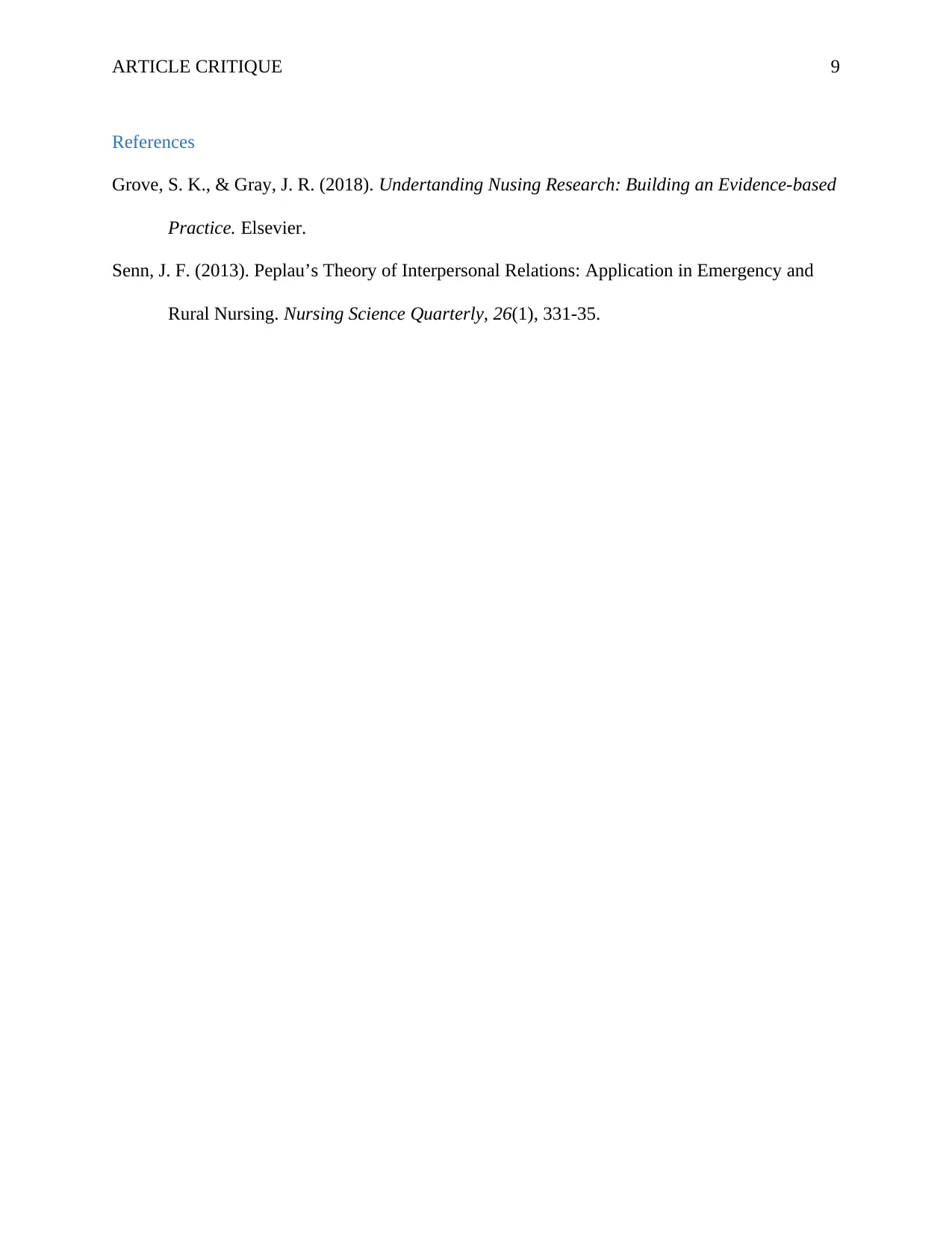
ARTICLE CRITIQUE 9
References
Grove, S. K., & Gray, J. R. (2018). Undertanding Nusing Research: Building an Evidence-based
Practice. Elsevier.
Senn, J. F. (2013). Peplau’s Theory of Interpersonal Relations: Application in Emergency and
Rural Nursing. Nursing Science Quarterly, 26(1), 331-35.
References
Grove, S. K., & Gray, J. R. (2018). Undertanding Nusing Research: Building an Evidence-based
Practice. Elsevier.
Senn, J. F. (2013). Peplau’s Theory of Interpersonal Relations: Application in Emergency and
Rural Nursing. Nursing Science Quarterly, 26(1), 331-35.
⊘ This is a preview!⊘
Do you want full access?
Subscribe today to unlock all pages.

Trusted by 1+ million students worldwide
1 out of 9
Related Documents
Your All-in-One AI-Powered Toolkit for Academic Success.
+13062052269
info@desklib.com
Available 24*7 on WhatsApp / Email
![[object Object]](/_next/static/media/star-bottom.7253800d.svg)
Unlock your academic potential
Copyright © 2020–2025 A2Z Services. All Rights Reserved. Developed and managed by ZUCOL.





